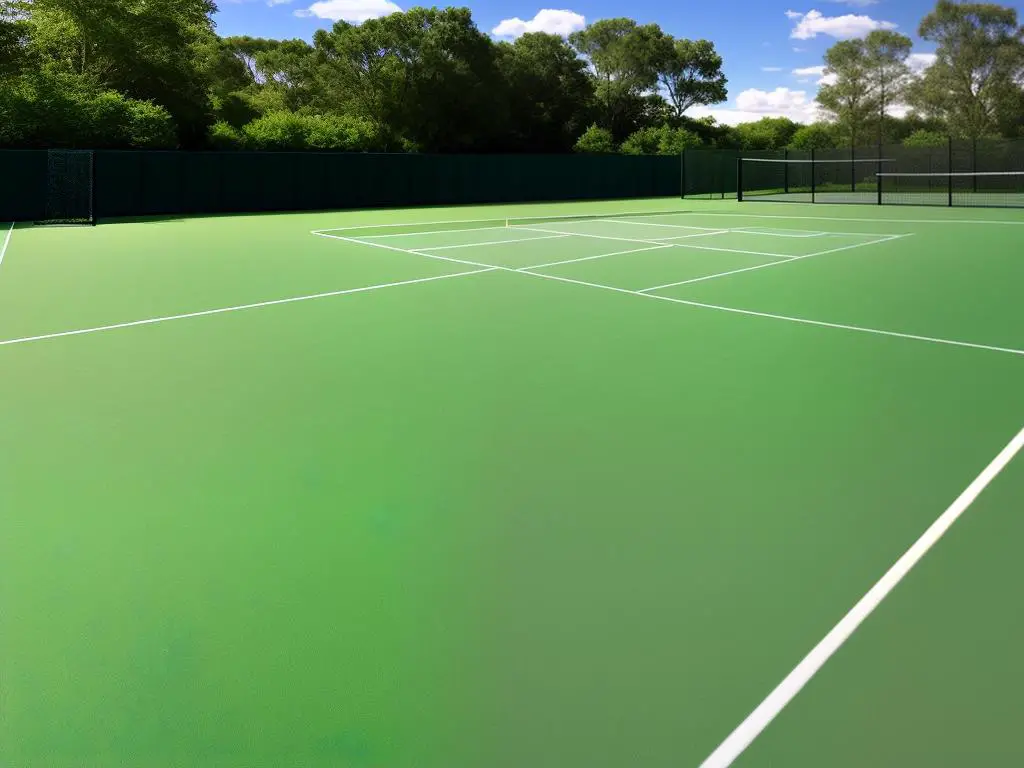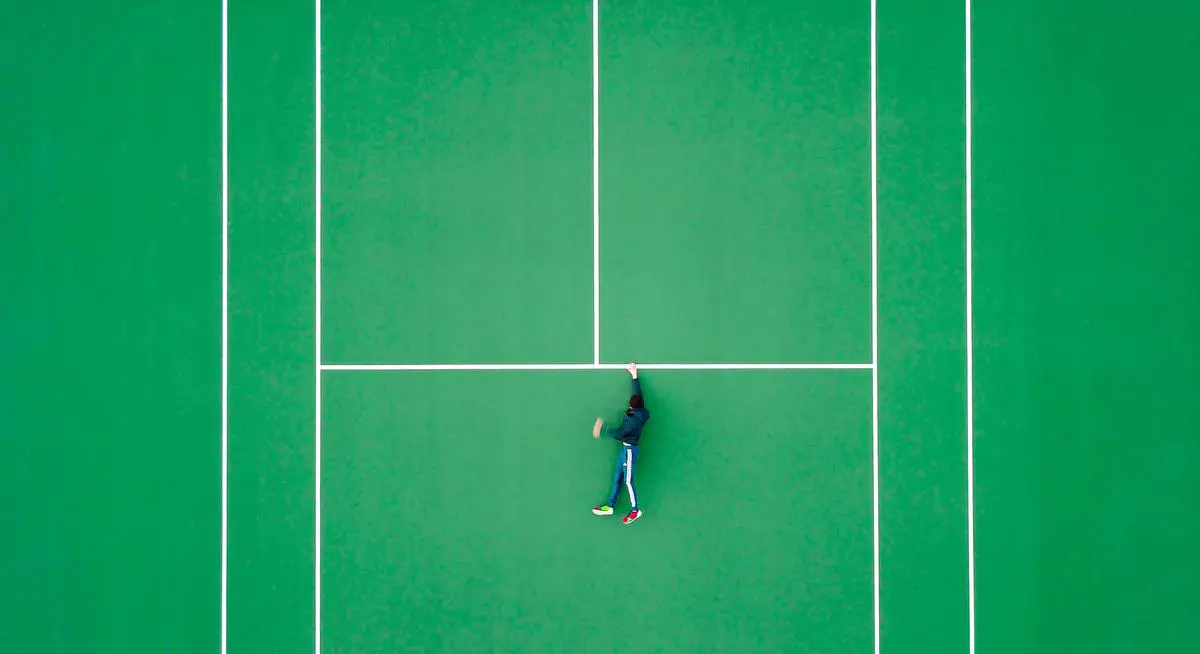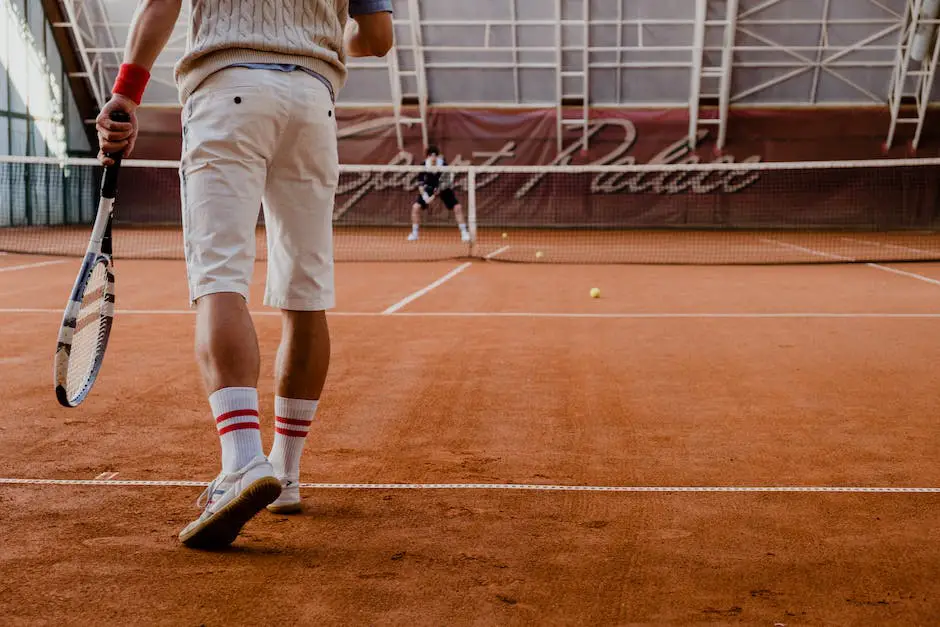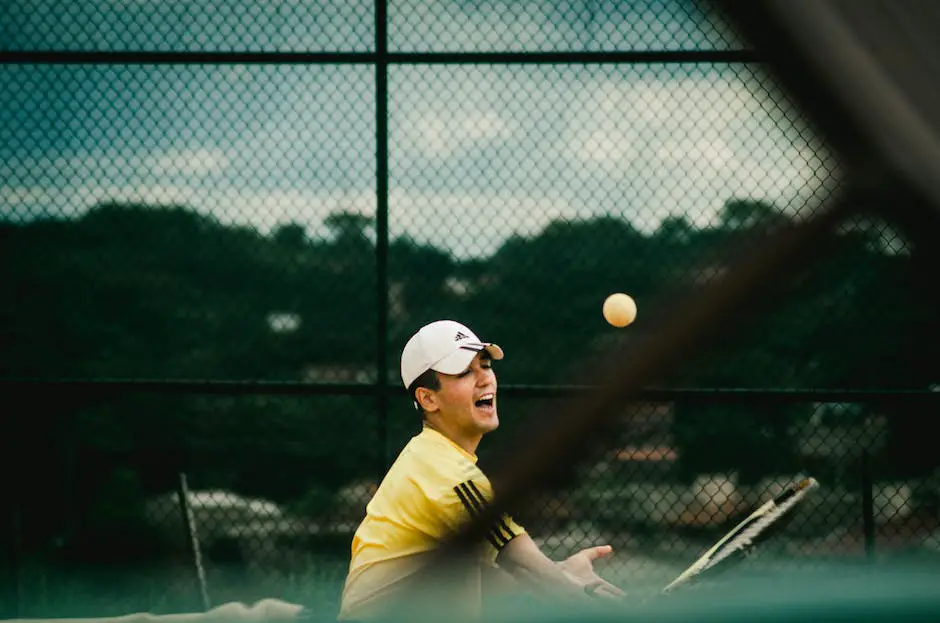Whether you’re a novice player or pursuing tennis professionally, comprehending the intricate layers of strategy involved in singles play can significantly skyrocket your performance. This understanding begins with getting familiar with the tennis court’s geometry, from service boxes to the baseline’s crucial role and the essentiality of the net play. This insight not only helps to enhance your ball placement skills to disorient your opponent but also opens the door to mastering effective singles play techniques, ranging from disarming serves and volleys to skilled baseline play and the ever-deceptive slice.
Understanding Tennis Court Geometry
Understanding the Tennis Court Dimensions
The regulation size for a standard tennis court for singles play is 78 feet long by 27 feet wide. The net stands at 3 feet 6 inches at the posts and 3 feet high in the center. Understanding these dimensions is the first step towards improving your tennis singles strategy.
Significance of Service Boxes in Tennis
Adjacent to the net, the tennis court has two rectangles on both ends known as the service boxes. The service boxes are crucial in a singles game as this is where your serve is aimed towards. After the serve, most of the play happens from the baseline. Therefore, strategic positioning in these areas can determine the outcome of the game.
Importance of the Baseline
The baseline is the last line of the court where most of your ground strokes are typically played. Dominating baseline play can put you in control of the match. However, you need to consider that hitting deep shots from the baseline requires more power and precision. Constantly hitting deep shots can wear out your opponent and force them into making errors.
The Role of Net Play in Singles Matches
Net play becomes a significant strategy in a singles match when you want to break the rhythm of a baseline rally. However, this move should be meticulously planned, and your approach shot must be robust enough to avoid providing your opponent with an easy passing shot. Execute your volleys efficiently, and always be prepared to react to a possible lob.
Playing with the Court Geometry
Understanding the tennis court’s geometry is crucial for developing an effective singles strategy. A good player takes advantage of the court space and tries to make the opponent run across the court, thus forcing them to play defensively. You should aim to keep your opponent moving and off balance by placing your shots wisely in different parts of the court.
The Concept of Court Coverage
Court coverage refers to your ability to reach and return shots on your side of the court. Your goal here should be to minimize the amount of running you have to do, while maximizing the opponent’s movement. A great strategy is to make use of angles, forcing your opponent to the extremes of their court space while you maintain a central position. This makes it easier for you to reach any return shots, offering you more control over the game. In singles, good court coverage combined with a deep understanding of court geometry can give you a significant advantage.
Understanding the intricacies of tennis court geometry and incorporating these tips into your singles strategy can greatly enhance your performance on the court. Keep practicing and remember, every game is an opportunity to learn more and refine your strategy.

Mastering Singles Play Techniques
Learning Serve and Volley Technique
When it comes to tennis singles strategy, serve and volley is a crucial technique to have under your belt. It cuts off your opponent’s reaction time as you advance closer to the net after an aggressive serve. To implement this technique, you’ll serve powerfully to the returner, usually aiming for their weaker side, before quickly moving towards the net.
As they return the serve, you’ll be in an optimal position to block or volley the ball, keeping it low and increasing their maneuvering difficulty. Remember to keep your first step fast right after the serve to position yourself appropriately for the volley.
Mastering Baseline Play
Success in tennis singles also lies in solid baseline play. For this strategy, your position would ideally be near the baseline, which is the rear line of the court. Here, you’ll aim for a deep ground stroke with your first hit, keeping the ball in the opponent’s half of the court.
The goal of the baseline strategy is to force the opponent to make errors by playing powerful and accurate shots repetitively. It’s essential to ensure your movements are dynamic, adjust your position as needed, and combine different strokes, including top spin or flat strokes.
Employing the Slice Technique
The slice technique is a handy tool in singles tennis especially for disrupting your opponent’s rhythm. This technique involves hitting the ball with a bit of backspin causing it to move slower than typical shots and bounce less upon landing.
When executing a slice, the racket should hit the ball in a high-to-low swinging motion. Practice hitting the ball by cutting under it, creating the downward spin necessary for a slice. The trick is to often use this strategy when your opponent least expects it, throwing them off their game and gaining an advantage.
Strategic Engagement on Court
An important part of singles play techniques in tennis is the strategy of moving your opponent around the court. This is achieved by alternating between hitting your ball down the line and cross-court shots. This tactic can exhaust your opponent, making it difficult for them to return the ball effectively.
Note that an effective strategy is always to aim for your opponent’s weakest side. Assess their strengths and weaknesses early on, and direct your strokes accordingly. Remember, consistency is key. Your main goal is to keep the ball in play and inch closer to gaining control of the volley.
Incorporating Lob Shots
Lob shots are another significant tennis singles strategy. It involves hitting the ball high and deep into the opponent’s court. It is primary used when the opponent approaches the net, thereby forcing them to revert and chase the ball. The key to success with lob shots is to disguise them well so that your opponent cannot anticipate them early on.
Conclusion
The road to mastering these techniques involves persistent practice and implementing them under varied game situations. So, prioritize enhancing these skills during training sessions and see significant improvements in your singles play strategy.

Photo by zekedrone on Unsplash
Studying Opponent Analysis
Opponent Analysis: Identifying their Strengths and Weaknesses
Opponent analysis in tennis singles revolves around identifying their strengths and weaknesses. To assess their strengths, study the techniques they employ to score points. For instance, notice whether they excel at serving or have an impressive backhand. On the other hand, identifying their weaknesses would involve figuring out the tactics they struggle with. This could be a weak forehand, difficulty handling high balls, or a struggle with backhand shots.
Understanding your Opponent’s Playing Style
Understanding your opponent’s playing style is a crucial aspect of analyzing their gameplay. Do they prefer a baseline play, or do they frequently come to the net? Are they aggressively offensive or prefer a more defensive play? These tendencies can give you an insight into their comfort zones and help you better prepare to meet their style of play.
Adapting your Game Plan
Once you’ve understood your opponent’s strengths, weaknesses, and playing style, you need to adapt your game plan accordingly. If your opponent has a powerful serve but weak backhand, strategizing to play more on his backhand side could give you an edge. If they prefer baseline play, concentrating on the bottom line could force them to play balls they’re not comfortable with. Plan your serves and returns considering your opponent’s weak areas to keep them off balance and make it challenging for them to score.
Watch and Learn
Studying your opponent goes beyond the court. Preferably, watching them play against other players can give you valuable insights into their playing style, techniques, and how they react under pressure. Their past matches, videos, and game records can provide you with information about their performance patterns, psychological disposition, and their consistency.
Continual Analysis & Strategy Adjustment
Opponent analysis is not a one-time task; it is an ongoing process throughout the match. Your opponent might change their tactics or improve their weak areas during the game. Thus, it’s necessary to continually analyze their play, adjust your strategy, remain flexible, and adapt in real-time. Paying close attention to their body language, movement, and energy level can give you hints about their current state and capacity to play.
Practice and Preparation
But beyond all, your abilities to capitalize upon your opponent’s weaknesses or resist their strengths would be contingent on your skill set. Regular practice, working on your strengths, improving your weaknesses, and staying fit are equally important in gaining a competitive edge in tennis singles.

Developing Mental Toughness
Developing Mental Toughness in Tennis Singles Strategy
Mental toughness is a significant part of tennis because the game not only demands physical fitness but emotional strength as well. You will need to gain control over your mindset, emotions, and reactions. This can be achieved through several different methods.
Understanding the Pressure
The first step towards developing mental toughness is understanding pressure. Pressure in tennis can come from various sources like high-stakes matches, tough competitors, or even your own expectations. It’s essential to recognize this pressure and accept it as part of the game. Recognize that it’s natural to feel pressure and it can actually enhance your performance if channeled correctly.
Maintaining Focus
The next important aspect of mental toughness is the ability to maintain focus. Distractions, both internal and external, can dramatically affect your play. Therefore, it’s crucial to develop the ability to block out distractions and keep your attention on the game. Focus on one point at a time, stay present in the moment and avoid thinking of past mistakes or future outcomes. Mental exercises such as meditation or visualization techniques can help improve your ability to concentrate.
Controlling Emotions
Being able to control your emotions, especially negative ones, can significantly improve your performance on the court. Anger, frustration, or fear can cloud your judgment and harm your gameplay. It’s important to recognize these emotions when they arise and deal with them effectively. You can use techniques like deep breathing, taking a moment between points, or changing your internal dialogue to positive and constructive thoughts. Remember, it’s the reaction to the emotion, not the emotion itself, that needs to be controlled.
Reacting to Ups and Downs
No game is a straight path. There will be ups and downs during a match and how you react to these can have a significant impact on the outcome. Develop a resilient mindset that takes setbacks in stride. It’s important to not let a few bad points or games affect your overall performance. Remember that losing points is part of the game. Use these as learning opportunities and motivation to improve rather than as a source of frustration.
Building a Strong Mindset
Ultimately, mental toughness in tennis comes down to building a strong mindset. It’s about being confident in your abilities, resilient in the face of adversity, and adept in maintaining concentration under pressure. Engage in regular mental training, seek advice from experienced players or coaches, and have a support network to discuss your feelings and enhance your mental toughness.
Remember, it’s not just about physical strength and technical skill in tennis, it’s also about winning the battle inside your mind.

Moreover, none of these foundational strategies in tennis would be complete without an in-depth study of your opponent and the development of significant mental toughness. Recognizing and exploiting your opponent’s weaknesses alongside enhancing your strengths based on their gameplay can provide an unmatched competitive edge. Meanwhile, mental resilience adds a finishing touch, helping maintain focus and emotional control through the match’s highs and lows, ensuring that under pressure you always bring your A-game. The blend of these elements places you on the path to becoming a formidable singles player.